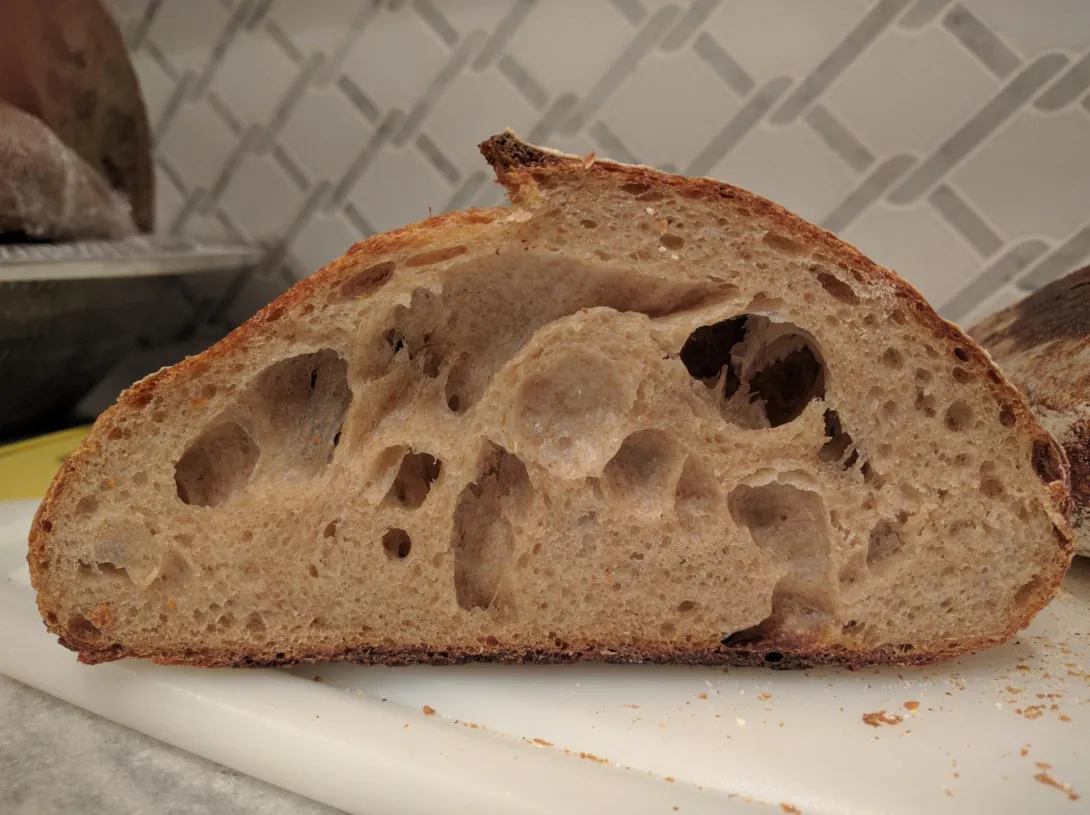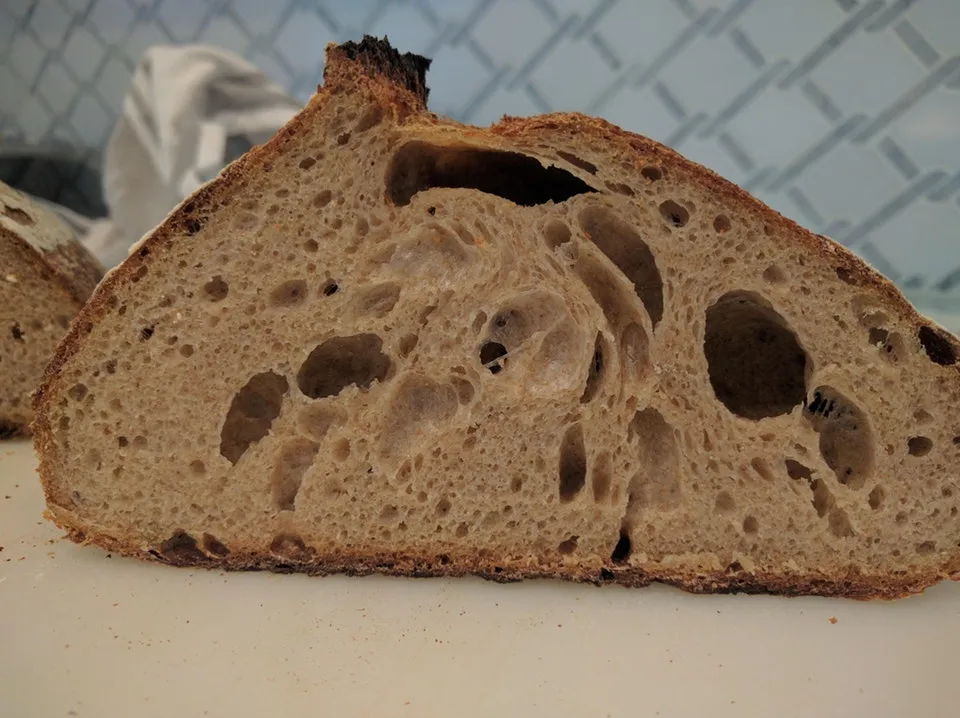

Looking for some help here, can't seem to diagnose the issue on my own. These are two different loaves, same recipe. Crumb turns out very dense, spongy. Air pocket distribution is pretty bad. After the first attempt, I ran under the assumption that my gluten development wasn't strong enough, so I focused more on the slap + fold process. Ended up with 10 minutes of slap + fold. I made sure I got more of the windowpane effect, but got the same result. Did I need to mix even more thoroughly? I feel like I could have gotten better stretch/windowpane, but I'm not sure.
Recipe
200 g levain (20 g starter, 50 g whole wheat flour, 50 g bread flour, 100 g water)
650 g bread flour
350 g whole wheat
725 g total water
23 g salt
1 hour autolyse of flour + 625g water; levain went for 5ish hours until float; mixed in levain w/50 g water, then mixed in salt with remaining 50g water. slap + fold for 10 minutes.
bulked for 4-5 hours, folds every 30 minutes (4 or 5 total). until dough held form + showed good activity. pre-shaped, then shaped into batards.
at one point, i thought shaping might have been the problem, so on the second loaf, i got a good, strong shape. ultimately had no effect.
these loaves then proofed in the fridge for 16 hours in bannetons.
standard dutch oven procedure to bake
could they be overproofed? the 16 hour cold retard seems like a lot. kind of frustrated because i've had great success with this recipe before.
so, to be brief - are these loaves overproofed, underproofed, or is the gluten not strong enough? really appreciate any help y'all can give me! thanks
First of all, it’s a decent loaf of bread. Nothing inedible ( and we’ve all seen those).
score card:
gluten development- very good
bulk ferment - ok, could be a bit longer
final proof- too long
cooking time- good, done and not dry
Suggestions: Perhaps your fridge is on the warm side.
What you could try ( depending on your schedule constraints) is
1) refrigerate for the end of bulk ferment, say after 2 hrs at room temp. Then take it out and shape it and do final proof at room temp so you can watch it. Should need about 2 hrs , depending on room temp.
Or
2) let the bulk run a bit longer ( or provide a slightly warmer temp somehow) and shorten refrigerated proof time
or
3) let bulk go a little longer and turn fridge a bit colder
thanks dude. yea it's definitely edible, but i can still tell that something's just not quite right
i definitely felt like 16 hours in the fridge was pushing it. no real reason, i just started the whole process a little too early in the day, so i was shaping and putting the loaves in the fridge in the early afternoon rather than at night.
possible underfermentation during bulk noted....i thought 4ish hours coupled with that long cold proof might be enough. the loaves definitely rose enough to fill the bannetons. but i'm guessing that bulk ferment and the cold retard are achieving two different types of fermentation?
notionally, the bulk ferment is the aerobic phase when the yeast is multiplying using the food in the dough and the air trapped in the dough from mixing, kneading and/or folding. The final proof is the yeast mostly respiring and not reproducing as much. Obviously, both activities happen in both phases, but the last time you add air is at shaping, which marks the last time oxygen is put in the dough. If there isn’t a healthy colony by the time you shape, leaving it in the pan (or basket) for longer only sours the bread.
I'd be inclined to drop the slap & folds, & just do the folding. Every 30 minutes seems too frequent, though. I normally give it an hour...I get better results when the dough seems poofy before folding, but you might not see that until the second fold.
but I am not an expert.... Trevor Wilson describes this in his book 'Open Crumb' with a photo and the characteristic are a few large holes surrounded by tight, dense crumb. He explains that this type of crumb is the result of underfermentation. He also commented on this site on one of his Champlain loaves and if I remember correctly explained that the 'sloping sides' of a loaf are also a sign of 'fool's crumb'.
Did you have a very active starter? Did you see lots of signs of fermentation during the bulk like bubbles etc?
Did the dough feel light and airy after the final shaping?
I hope this helps and also recommend Trevor's ebook highly... Kat
"Fool's Crumb"?? I don't have Trevor's book and I never heard the term. It is almost impossible to find any info searching (google) or here on TFL. Can you provide a little more info? Links?
used in his ebook 'The Open Crumb' but you might find it helpful to read his suggestions and thoughts on some Champlain loaf bakes on TFL
http://www.thefreshloaf.com/comment/399127#comment-399127
when he kindly reviewed some Champlain bakes and also refers to this term and describes what he means by it. I cannot unfortunately provide any other information. If you scroll up you can see photos of the loaves that he refers to and I hope it is useful. Kat
damn this is super helpful!!
here's what he says about the Fool's Crumb. given this info, i probably didn't let my levain develop enough AND didn't bulk long enough...sort of as a result/product of the underfermented levain?
"Dan, the difference between your two loaves from above is that the second loaf was underfermented during the bulk. You can see it in the dough (it looks heavy and has a clean smooth skin without much in the way of surface bubbling), you can see in the shape of the loaf (tall in the center and sloping heavily towards the sides indicating insufficient gas/structure to hold a round full shape), and you can see it in the crumb (a few large holes surrounded by tight dense crumb – what I referred to as Fool’s Crumb in my book).
If you compare your dough to Kat’s later attempts you can really see the difference in airiness between the two doughs. Hers has bubbles and shape. A certain lightness. Yours looks heavy and dense. Too young. I’m not trying to pick on you, just trying to help you understand what to look for.
Underfermentation can have several causes, but usually it comes from an insufficiently active starter. Assuming that your temps were warm enough, and that you gave it plenty of bulk time, then it’s probably a starter/leaven issue."
:)
In a different thread Dan and I invited people to bake Trevor's Champlain loaf as a 'community' bake. Many participated and documented their bake in quite some detail. It is a long thread but you may find it useful to look at the photos and see what type of fermentation people did get with what result...Happy Baking...
http://www.thefreshloaf.com/node/55230/anyone-interested-champlain-sd-bake
Kat
If you choose do the Champlain bread, you can document your progress and submit photos to the link Kat gave you. I am sure that Kat and I and others will respond with help if needed.
http://www.thefreshloaf.com/node/55230/anyone-interested-champlain-sd-bake
A gang of us learned a lot by participating.
Dan
could it be that flour got trapped inside the dough during the shaping process?
I never had this happen to me. So, it’s just a thought.
Dan
could it be that flour got trapped inside the dough during the shaping process?
I never had this happen to me. So, it’s just a thought.
Or, maybe air got trapped between the layers while shaping.
Dan
Thanks - do you mean from like flouring the top side of the loaf before shaping? Or from the table or something?
I’m just grasping at straws. I thought maybe when your were shaping the dough that flour may have gotten folded into the inside of the dough. If the dry flour was trapped inside the dough it might produce pockets (because the dough couldn’t seal) in those dry areas.
Does anyone else think this could be a possible scenario?
Dan
very possible, because i flour the ball lightly, flip it, then stretch it out and shape it. so theoretically, portions of the floured top are getting rolled in on themselves during the shaping.
but it's the density of the other parts of the dough that i find to be indicative of a bigger problem, like lack of fermentation or overpoofing as was suggested by others.
only one more day of work left before i can try these suggestions out!
I vote underproofed with a combination of other variables. Try adding a pinch of instant yeast and repeat one of the recipes. If the loaf changes to the better then in the future, wait on the levain until it is more yeasty before using.
Let's see, the 1:5:5 levain ratio was used after only 5 hours and the dough was 200 starter to 1kg flour. If the levain was not ready that would slow things down letting you get ahead of the dough with the shaping. Any temp readings?
dough started off around 78F but after an hour or so it was in the 75F and below range.
is that a pretty normal/acceptable amount of levain to flour? i don't know a ton about relative amounts of levain and how that affects the ultimate product.
I find 200g a bit low and slow, even with 4 hours wait before the fridge, I'd be tempted to shape after the retarding or about half way thru the retard if it rose too fast, returning it back to the fridge until baking. But you said you had success with the recipe before so I suspect the starter is the problem and was used too early.
How long does the starter take to peak out at 20g starter 100g flour and 100g water?
Relative levain amounts... roughly ...not over half the flour weight and when it gets that high, don't leave the kitchen. :). A third of the flour weight, in this case 333g would get you a decent 3 - 4 hr bulk, a degas/ divide and overnight retard. I tend to use between 150 and 170g levain per 500 g flour.
.
ok - most recent attempt
made sure the levain was fully developed, also took bulk long enough to see significant activity
what do y'all think?
Still some pretty large holes but overall a better looking crumb to me.
I have been following this thread but I was puzzled as your initial crumb had characteristics of being both under and overproofed at the same time. I wanted to hear the outcome. This crumb seems properly fermented and proofed.
" had characteristics of being both under and overproofed at the same time."
lol! Only i could pull something like that off.....
how would i eliminate the oversized holes in this bread? someone on another forum suggested a longer bulk
...Pop any you see and feel while shaping. :)
Reducing the bubbles to about the same size before shaping will give a more readable rise and uniform sizes. Don't have to flatten the dough and reduce all the gas cells, just pop the big ones or press them to double them down creating several bubbles from each one. Sort of like shaping for focaccia (just not so deep) with finger tips denting all over the dough... and watch the edges, big bubbles can slip "past control" while rolling up. Have a sharp implement handy.